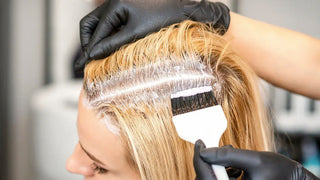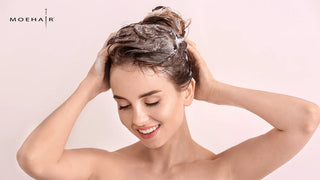 Table of contents
Table of contents
Hair color trends change from time to time, but something that remains constant is its companion – hair color developer. The magic of hair color, especially the permanent color range, happens when mixed with the right hair developer. When combined with color, it opens the cuticles and ensures the absorption of color through strands. Whether you want to darken or lighten the existing color or shift the natural shade slightly, the developer is an integral part of the coloring process. We have delved deeper to lay down everything about hair developers, their formulation, and usage on the table.
What is a hair color developer?
Also known as an activator, hair color developer is an oxidant cream used with permanent hair color to improve the pigments' absorption. It is infused with hydrogen peroxide, which blasts open the cuticles and allows color to penetrate through the hair shaft. As a result, it enhances the tone vibrancy and fade-proofs the tresses. When combined with permanent hair dye, toner, or bleach, it activates the product, ensuring an effective result.
Benefits of using hair color developer
- Color Absorption – The hydrogen peroxide in the developer opens cuticles and eases the process of color delivery and penetration. It ensures maximum vibrancy as it locks the deposited pigments.
- Color activation – The color developer for hair activates the dye pigment, enabling efficient and faster processing and making it suitable for all hair types.
- Lasting coloring results — The hair dye interaction with the developer gives long-lasting results, as pigments are absorbed through the cortex.
- Salon-grade coloring process - Pairing up permanent dye with a hair color developer for professional salon-grade hair coloring gives the desired outcome. Depending on the developer's volume, you can use the product to either darken or lighten the color compared to natural shade.
- Color consistency — Mixing developer with hair color helps create a thick, non-drippy, and uniform consistency, making the application effective and easy.
Often, the hair coloring process revolves around two main ingredients ensuring permanent hair color stays on for a longer duration:
- Hydrogen peroxide — The primary ingredient of hair developer and also known as an oxidizing agent. It activates the color and opens the cuticles so that the color molecules can penetrate the strands. The strength of the developer varies depending on the percentage of hydrogen peroxide.
- Ammonia - is an alkaline agent that is present in the hair color and acts as a catalyst in activating dye molecules when permanent hair color comes in contact with peroxide. Ammonia helps permanent hair color to penetrate the cortex of the hair.
Types of hair color developer

Choosing the right developers for hair color is essential, considering the percentage of hydrogen peroxide and the tone you intend to achieve. Here are the different hair developer volumes and how they help with the hair coloring process:
5 Volume Hair Color Developer
It is the lightest developer with 1.5% hydrogen peroxide, primarily used with toners, glazers, or semi-permanent hair colors. The deposit-only color developer doesn't open cuticles, so it offers no color penetration through the cortex. Nevertheless, it ensures the deposit of vibrant dye pigments.
10 Volume Hair Color Developer
The 10-volume developer with 3% hydrogen peroxide is a no-lift developer that offers hair darkening by up to 1 level. Often used with semi and demi-permanent hair colors, it helps with gentle color deposit and works on shifting color from lighter to a darker hair shade. Owing to its low hydrogen peroxide, it is used as a default developer with toners and glazers, slightly changing natural shade.
20 Volume Hair Color Developer
The most common type of hair developer used with permanent hair color consists of 6% hydrogen peroxide that gives 2 – 3 levels of lift. It offers excellent 100% gray coverage and is the most suitable choice for darkening hair color by up to 3 levels. The developer helps neutralize brassy red, yellow, and orange undertones. If you want a developer that eliminates unwanted brassiness, try Moehair 6% 20-Volume Anti-Yellow Hair Color Developer.
30 Volume Hair Color Developer
The 30-volume developer contains 9% hydrogen peroxide, which can lift the color by 3 – 4 levels. Optimal for gray coverage, it is a strong developer that helps lighten hair by up to 4 levels. The formulation is ideal for people with thick and coarse hair. It is recommended that individuals with thinner hair seek professional guidance.
40 Volume Hair Color Developer
The 40-volume developer is known for its strong formulation with 12% hydrogen peroxide that offers up to 8 levels of lift. Higher hydrogen peroxide helps lighten even the darkest shade of hair. Consult a professional before using it, as it is a salon-grade product.
50+ Volume Hair Color Developer
The 50+ volume developer has a high hydrogen peroxide level, limiting its use. Owing to its strong formulation, it is crucial to tread caution while mixing and using the developer with hair color. Such developers often used hand-painted color techniques to obtain the right highlights, lowlights, or balayage.
How do you choose the right developer?
With the difference in the percentage of hydrogen peroxide in the developer, the overall strength too varies. Here are a few factors to consider when choosing the right developer:
Color Type:
- Semi and demi-permanent colors — For use with semi- and demi-permanent hair color, toners, and glazers, opt for a developer with a lower percentage of hydrogen peroxide. Using 5 and 10-volume developers for no-lift, deposit-only color is recommended.
- Darkening hair — If you want to darken hair by up to 3 levels, opt for the 20-volume hair color developer. It helps shift a lighter existing shade or natural color to a deep color tone.
- Lightening hair – 30 and 40-volume developers help with lightening hair. The 30-volume developer lightens hair by up to 4 levels, whereas 40 volume can lighten hair by up to 8 levels.
Read More -How To Use Hair Color Developer
Hair Porosity Level
The choice of hair color developer also depends on overall hair type and texture. Consider factors like hair porosity before choosing a developer formula. High porosity hair has open cuticles that absorb and lose moisture quickly, resulting in dryness and frizz. On the other hand, the low porosity hair closed cuticles that cause resistance to moisture absorption. As high-porosity hair absorbs color faster and is prone to quick fading, it is best to opt for a 30-volume for lightening hair. A 20-volume hair color developer is ideal for better pigment penetration for darkening hair. However, for low-porosity hair, a stronger developer is recommended by professionals for better cuticle opening and color absorption.
Read More - What is Low Porosity Hair, and How to Take Care of it?
Hair Texture
The developers for hair color work differently on varying hair types and textures. For thin and fine hair, using a low-volume developer is recommended as it minimizes damage and helps with better pigment penetration. A stronger developer is recommended for lasting color for thicker and coarser-textured hair. It is advised to consult an expert and professional hair colorist before weighing down your options.
How to use hair color developer
Irrespective of the hair type and texture, the hair coloring process requires appropriately mixing the developer with the color. Uniform consistency and mixing ratio help in optimal cuticle opening and penetration of the dye. While the ratio varies from brand to brand, here are some standard mixing ratio (Hair Color: Developer) that helps in delivering the desired impact:
- 1: 1 Ratio — Mixing equal ratios of hair developer and color helps achieve a shade closer to the natural hair color.
- 1 : 1.5 Ratio – Mixing 1 part of the developer to 1.5 part hair color is ideal for lightening hair by up to two levels. Also, it is an excellent ratio for root touch ups and covering grays.
- 1: 2 Ratio – This ratio is ideal for lightening hair by up to 3 to 4 shades.
Note: Read the instructions on the box and follow them for the best results.
Tips for best hair coloring results
While mixing the hair color developer with color in the right ratio is the most straightforward tip for obtaining the best coloring results, it takes a little more than that. We tapped some experts and zeroed in on tips that deliver excellent coloring outcomes.
- The majority of people agree that it is best to leave it to a professional. It is best to consult an experienced hair colorist and perhaps get your hair colored by experts, especially when it involves a high-volume developer.
- Choose the developer depending on the desired lift you expect to achieve. The 20-volume developer is perfect for darkening hair by up to 3 levels. On the other hand, 30 volume developers and 40 volume developers are apt for lightening hair.
- Choose the developer depending on the desired lift you expect to achieve. The 20-volume developer is perfect for darkening hair by up to 3 levels. On the other hand, 30 volume developers and 40 volume developers are apt for lightening hair.
- Developers are meant for immediate use. Mix developer to hair color only when you are ready to apply the color mixture.
- Never compromise on the quality of the hair color developer. Make it a point always to use a professional-grade, high-quality developer to minimize hair damage.
- After coloring your hair, aftercare is equally important. Always use color-safe products that are free of sulfate and paraben. You can try Moehair Color Alive Shampoo and Conditioner. Limit the use of heat styling tools, as they open cuticles, leading to faster fading of color. Always use a heat protectant spray like Moehair Thermal Shield Heat Protectant Spray before using hot tools.
With the right developer, you can color your hair and achieve the desired shade. Flaunt your beautifully colored hair, but don't forget a good aftercare routine for its wholesome health.
Take our Hair Quiz for personalized hair care recommendations.
FAQs
Q1. What developer should you use with hair color?
The choice of hair color developer depends on the levels of lift you wish to get and your hair color. 10 volume developers give up to 1 level of lift with no cuticle opening. the 20-volume developer gives up to 2 – 3 levels of lift and helps in darkening hair by up to 3 levels. 30-volume developer lightens hair by up to 4 levels, and 40-volume developer lightens hair by up to 8 levels.
Q2. Is a 20 or 30-developer better for gray hair?
20 volume is the standard hair color developer that offers excellent gray coverage and lift by up to 2 – 3 levels. 30 developer however is recommended for someone with less gray hair but wants to lighter hair by 3 – 4 levels.
Q3. How long should I leave the developer on hair?
The developer and hair dye are mixed for the hair color processing. Generally, the mixture is applied to the hair and left on for 30 – 45 minutes, depending on hair type and expected results.
Q4. What happens if I use 20 volume developers instead of 10?
10-volume deposit-only developer deposits color molecules on hair strands, commonly used demi-permanent colors, toners, and glazers. 20-volume developer, however, helps open cuticles and lifts hair color by 2 to 3 levels.
Q5. What is the appropriate developer-to-hair color mixing ratio?
The developer vs. hair color ratio varies depending on the desired outcome, the type of hair coloring you expect, and your hair type. It is highly recommended that you read the instructions as they vary depending on the brand.
References
https://www.shape.com/lifestyle/beauty-style/low-high-porosity-hairhttps://science.howstuffworks.com/innovation/everyday-innovations/hair-coloring2.htm
How we reviewed this article:
Our experts continually monitor the fashion and beauty space, and we update our articles when new information becomes available.
-
Current Version
-
Jun 7, 2024
Written By -
Upasana Kakati is a lifestyle writer with 7+ years of experience in writing in the beauty and haircare industry.
Edited By -
Saima Ahmed with 8+ yrs of experience, specializes in crafting engaging content focused on Hair care, lifestyle, and beauty.






















